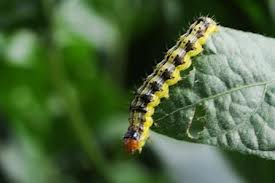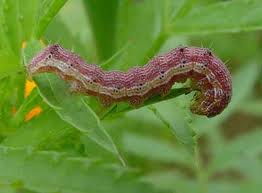Corn Earworm (Soybean Podworm)
go.ncsu.edu/readext?202019
en Español / em Português
El inglés es el idioma de control de esta página. En la medida en que haya algún conflicto entre la traducción al inglés y la traducción, el inglés prevalece.
Al hacer clic en el enlace de traducción se activa un servicio de traducción gratuito para convertir la página al español. Al igual que con cualquier traducción por Internet, la conversión no es sensible al contexto y puede que no traduzca el texto en su significado original. NC State Extension no garantiza la exactitud del texto traducido. Por favor, tenga en cuenta que algunas aplicaciones y/o servicios pueden no funcionar como se espera cuando se traducen.
Português
Inglês é o idioma de controle desta página. Na medida que haja algum conflito entre o texto original em Inglês e a tradução, o Inglês prevalece.
Ao clicar no link de tradução, um serviço gratuito de tradução será ativado para converter a página para o Português. Como em qualquer tradução pela internet, a conversão não é sensivel ao contexto e pode não ocorrer a tradução para o significado orginal. O serviço de Extensão da Carolina do Norte (NC State Extension) não garante a exatidão do texto traduzido. Por favor, observe que algumas funções ou serviços podem não funcionar como esperado após a tradução.
English
English is the controlling language of this page. To the extent there is any conflict between the English text and the translation, English controls.
Clicking on the translation link activates a free translation service to convert the page to Spanish. As with any Internet translation, the conversion is not context-sensitive and may not translate the text to its original meaning. NC State Extension does not guarantee the accuracy of the translated text. Please note that some applications and/or services may not function as expected when translated.
Collapse ▲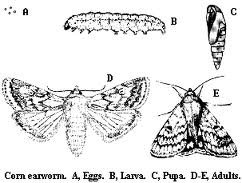
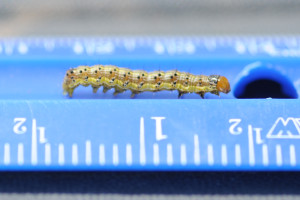
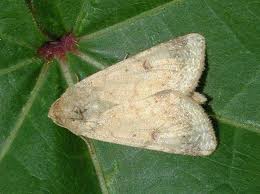
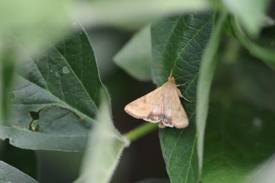
Indentification: The adult corn earworm is a robust light brownish-tan, rust- tan or olive-tan to olive, fast flying moth with a 1” to 1 1/2” wingspan. This moth has greenish eyes when living and a prominent dark spot on each forewing. The moths are active during the evening and dark hours but can be commonly seen in fields during the day. Eggs are laid individually on soybean terminals, flowers and leaves. Eggs can be easily seen (round, white to yellowish egg of about the size of a period in this text).
Caterpillars have five pair of fleshy prolegs and range in size from 1/16” (newly hatched) to 1 3/4” (last stage) long. When these larvae fall from the soybean plant they usually curl into a tight circle. Color varies considerably but small larvae are usually brown with a dark head and larger larvae may range from green, yellowish, to black with distinct cream-colored bands running the length of the body; the head color on large larvae is usually orange.
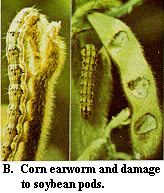
Injury and damage: On soybeans, the corn earworm may feed on foliage, flowers, and fruit. Eggs are laid over the entire plant, but small caterpillars must have tender vegetative terminals and/or flower clusters for high survival. Soybean fields that bloom during the moth flight are most likely to be infested above the economic threshold, although pre-bloom soybeans sometimes have high caterpillar abundance. Soybeans that bloom early, before the moth flight, usually escape infestation. The most serious yield losses occur when large corn earworm larvae coincide with soybean seed that have achieved almost full size. This is when caterpillars feed exclusively on seeds and have a large appetite. Feeding by small caterpillars on terminals, flowers, and small pods does not reduce yield. However, occasionally large caterpillars will cause severe defoliation that will reduce yield.
Economic Threshold: The threshold for corn earworm is dependent upon the sampling method, cost of control, row width, and soybean price. The threshold does not decline when prices are above $10/bu because soybean can compensate for low levels of pod injury. An online calculator for determining the threshold level in podding soybeans can be found by clicking the following link: Corn Earworm Threshold Calculator for Soybeans.
In flowering soybeans, remember that a soybean plant produces many more flowers than it can convert into pods and seeds. Recent studies conducted in NC have shown that corn earworm larvae can eat and injure flowers, but that the soybean plant compensates for this loss. Yield losses were not recorded even with corn earworm levels three times higher than the economic threshold for podding stage soybeans. There are very few cases when corn earworm larvae should be sprayed in flowering soybeans.
Cultural Control: Corn earworm typically reaches the highest populations, and does the most severe damage, in flowering, open canopy, and stressed soybeans which have had the biological control organisms removed with insecticide. Therefore, management practices that avoid these causes will help keep caterpillar numbers below threshold levels. Tactics which help maintain low populations include: using early varieties (Grp. V and earlier) that are early planted, establishing favorable growth conditions (pH, fertility, moisture), using narrow rows (that close the canopy quickly), and avoiding soil systemic and foliar insecticides in early season. Creating an unattractive, healthy crop with high levels of biocontrol organisms will greatly reduce corn earworm infestation levels.
Insecticide management: Ideally, treatment should be directed to mid-size larvae since control of small larvae is sometimes difficult (they are within flower clusters, terminals, etc) and large larvae may have already caused economic loss. Note that during 2019, NCSU entomologists began encouraging growers to restrict the use of chlorantraniliprole (Besiege and Prevathon) in soybeans to preserve its utility in cotton. Soybean growers have a number of effective insecticides for corn earworm at their disposal (e.g., indoxacarb, spinetoram, and spinosad).
In the past, pyrethroid insecticides were most commonly used to reduce corn earworm numbers below the economic threshold, but this insect is now resistant to pyrethroids in the state. Furthermore, some populations of “corn earworm” in soybeans have recently been found to be composed of mixed populations of corn earworm and tobacco budworm (Heliothis virescens Fabricius). Tobacco budworm has long been resistant to pyrethroids.



